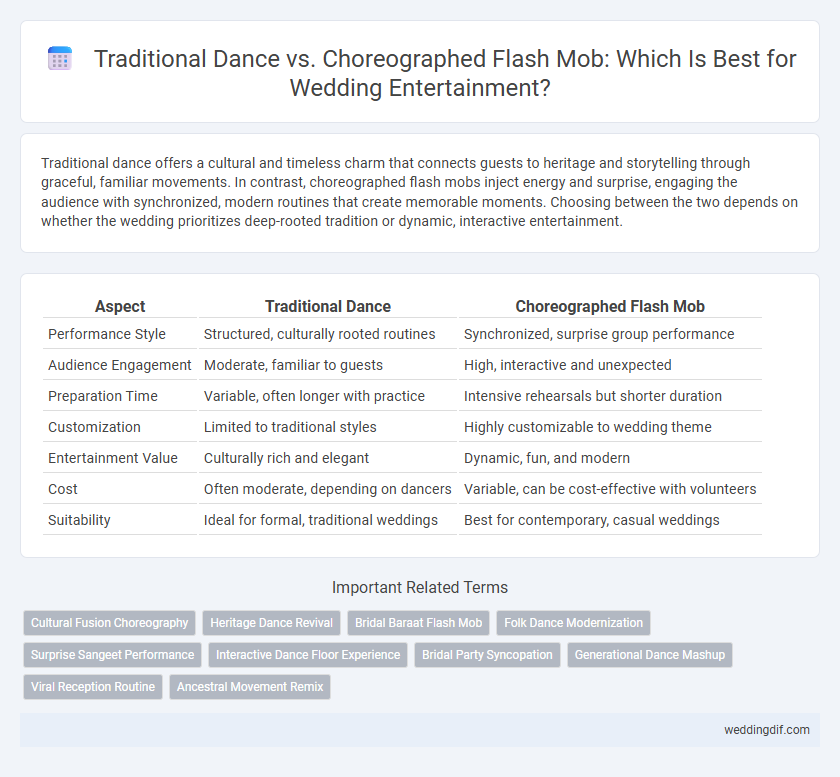Traditional dance offers a cultural and timeless charm that connects guests to heritage and storytelling through graceful, familiar movements. In contrast, choreographed flash mobs inject energy and surprise, engaging the audience with synchronized, modern routines that create memorable moments. Choosing between the two depends on whether the wedding prioritizes deep-rooted tradition or dynamic, interactive entertainment.
Table of Comparison
| Aspect | Traditional Dance | Choreographed Flash Mob |
|---|---|---|
| Performance Style | Structured, culturally rooted routines | Synchronized, surprise group performance |
| Audience Engagement | Moderate, familiar to guests | High, interactive and unexpected |
| Preparation Time | Variable, often longer with practice | Intensive rehearsals but shorter duration |
| Customization | Limited to traditional styles | Highly customizable to wedding theme |
| Entertainment Value | Culturally rich and elegant | Dynamic, fun, and modern |
| Cost | Often moderate, depending on dancers | Variable, can be cost-effective with volunteers |
| Suitability | Ideal for formal, traditional weddings | Best for contemporary, casual weddings |
Origins and Cultural Significance of Traditional Wedding Dances
Traditional wedding dances originate from cultural rituals deeply embedded in communities, symbolizing unity, blessings, and heritage passed down through generations. These dances often feature specific steps, costumes, and music that reflect the couple's ancestry and regional identity. In contrast, choreographed flash mobs are contemporary, dynamic performances designed for surprise entertainment, lacking the intrinsic cultural narratives that define traditional wedding dances.
What Defines a Choreographed Flash Mob at Weddings?
A choreographed flash mob at weddings is defined by its surprise element, coordinated dance routine, and active involvement of a group of participants who typically rehearse beforehand to deliver a synchronized performance. Unlike traditional dances rooted in cultural or familial heritage, flash mobs are modern, scripted, and designed to create a memorable and energetic atmosphere that captivates guests. These performances often incorporate popular music and contemporary choreography, highlighting creativity and spontaneous entertainment value.
Guest Engagement: Traditional Dances vs. Flash Mobs
Traditional dances at weddings foster guest engagement through cultural connection and participatory movements that invite attendees to join in, creating a warm, inclusive atmosphere. Choreographed flash mobs captivate guests with surprise and synchronized energy, generating excitement and encouraging active involvement through dynamic performances. Both styles enhance entertainment value differently, with traditional dances emphasizing heritage and community, while flash mobs highlight modern creativity and interactive spectacle.
Entertainment Impact: Creating Unforgettable Wedding Moments
Traditional dance offers authentic cultural expression and deep emotional connection, creating timeless and memorable wedding moments that resonate across generations. Choreographed flash mobs inject surprise and dynamic energy, captivating guests through coordinated performances that transform the atmosphere instantly. Both entertainment forms enhance wedding celebrations by engaging attendees and crafting unforgettable, personalized experiences.
Ease of Preparation: Traditional Rehearsals vs. Flash Mob Practices
Traditional dance performances typically require weeks of rehearsals with consistent practice to master complex steps and synchronize group movements, ensuring cultural authenticity and precision. In contrast, choreographed flash mobs for wedding entertainment involve shorter, more flexible practices, often designed to accommodate participants with varying skill levels and limited availability. The ease of preparation for flash mobs makes them a popular choice for spontaneous, lively moments, while traditional rehearsals demand more commitment and time to achieve polished results.
Role of Professional Dance Instructors in Weddings
Professional dance instructors play a crucial role in both traditional dance and choreographed flash mobs for wedding entertainment by tailoring routines to match the couple's cultural heritage and personal style. Their expertise ensures polished performances, enhances participants' confidence, and transforms wedding moments into memorable highlights through well-structured choreography and rehearsals. Instructors also facilitate seamless integration of diverse dance forms, making the celebration culturally rich and engaging for all guests.
Adapting Dance Styles to Wedding Themes
Traditional dance at weddings offers authentic cultural expression and a deep connection to heritage, enhancing the ceremony's intimacy and meaning. Choreographed flash mobs bring dynamic energy and surprise, perfectly suited for modern, themed weddings that emphasize entertainment and guest engagement. Selecting a dance style that aligns with the wedding theme ensures a cohesive atmosphere and memorable experience for attendees.
Inclusivity: Encouraging All Ages to Participate
Traditional dance at weddings fosters inclusivity by inviting guests of all ages to join in familiar, cultural movements, creating a shared sense of community. Choreographed flash mobs also encourage participation but often require rehearsals and coordination, which may limit spontaneity and accessibility for older or less experienced dancers. Prioritizing simple steps and open invitations in either format ensures that everyone can contribute to the celebratory atmosphere, enhancing collective enjoyment.
Visual Appeal: Costumes, Music, and Performance Elements
Traditional dance at weddings captivates with elaborate costumes reflecting cultural heritage, authentic music played live with traditional instruments, and performances emphasizing storytelling and intricate footwork. Choreographed flash mobs offer synchronized group movements with modern, diverse music tracks, often featuring casual or themed costumes that enhance surprise and energy. Visual appeal in traditional dance relies on rich cultural symbolism, while flash mobs prioritize dynamic formations and contemporary flair.
Choosing the Perfect Dance: Factors to Consider for Your Big Day
Traditional dance offers cultural richness and personalized storytelling that enhances the emotional connection on your wedding day, while choreographed flash mobs provide energetic surprise and memorable entertainment for guests. Consider factors like your wedding theme, guest demographics, and the desired atmosphere to determine which style best complements your celebration. Budget and rehearsal time also influence the choice, ensuring the performance aligns seamlessly with your big day's flow and vision.
Traditional dance vs choreographed flash mob for wedding entertainment Infographic

 weddingdif.com
weddingdif.com